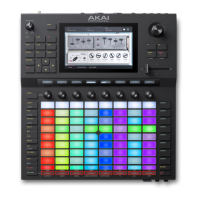252
Resonance Resonance or emphasis is an important filte
parameter. It emphasizes the frequencies around
the filter cutoff frequency by amplifying them with a narrow bandwidth. This is one of the most
popular methods of manipulating sounds. If you increase the emphasis to a level where the filter
enters a state of self-oscillation, it will generate a relatively pure sine waveform.
Root Key
The root key defines the original pitch of a recorded instrument or of a sample. Samples in
Force contain the dedicated root key information. This information will be created automatically
during recording or importing.
Sample When you tap the pads on your Force hardware, you can trigger sounds that we call samples.
Samples are digitized snippets of audio that can be recorded using the recording (sampling)
function of your Force hardware or loaded from the Browser.
You can edit and process a sample in different ways. For example, a sample can be trimmed,
looped, pitch-shifted or processed, using various effects. When you have finished editing your
sample, you can assign it to one or more drum pads to play it. Samples can be either mono or
stereo.
Sample Rate
This is the frequency representing the amount of individual digital sample scans per second that
are taken to capture an analog signal digitally. For normal CD audio recordings, 44100 samples
per second are used, also written as 44.1 kHz.
Scene
group of clips in the same row.
Stretch Factor The stretch factor is a value generated by the Warp algorithm in the software. When you record
an audio file, the current project tempo will be embedded with it. This information is stored
within the sample file when you save the project. When you warp an audio track region, the
warping algorithm uses this project tempo and the current value in the BPM field to generate
the stretch factor.
Sustain This term describes the level of an envelope remaining constant after it has passed the attack
and decay phases. Once reached, the sustain level is kept until the trigger is terminated.
Time-Stretch See Warp below.
Trac
project on your Force hardware can contain 128 MIDI tracks and 8 audio tracks.
Each MIDI track contains MIDI note events and controller data. In this case, the track contains
no audio information—only MIDI information that uses the samples in a drum track or keygroup
track (or an external MIDI sound module) to generate its audio. You can edit your performance
in many different ways once the performance has been captured.
Each audio track contains an audio signal that has been recorded or imported into your
project. You can edit this audio within the software and incorporate it into your project alongside
your MIDI tracks.
Trigger
trigger is a signal that initiates events. Trigger signals are very diverse. For instance, a MIDI
note or an audio signal can be used as a trigger. The events a trigger can initiate are also very
diverse. A common application for a trigger is its use to start an envelope.

